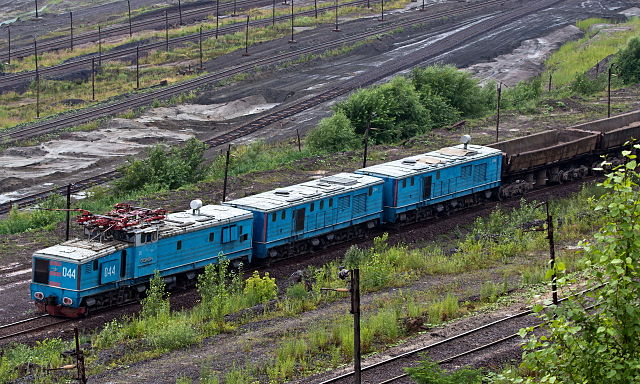Loading AI tools
Railway locomotive capable of running either under electrical or diesel power From Wikipedia, the free encyclopedia
An electro-diesel locomotive (also referred to as a dual-mode or bi-mode locomotive) is a type of locomotive that can be powered either from an electricity supply (like an electric locomotive) or by using the onboard diesel engine (like a diesel-electric locomotive). For the most part, these locomotives are built to serve regional, niche markets with a very specific purpose.


Electro-diesel locomotives are used to provide continuous journeys along routes that are only partly electrified without a change of locomotive, avoid extensive running of diesel under overhead electrical wires and giving a solution where diesel engines are banned. They may be designed or adapted mainly for electric use, mainly for diesel use or to work well as either electric or diesel.
Note that, as well as the electric multiple unit (EMU) and diesel multiple unit (DMU), where no discrete locomotive is present, an electro-diesel (bi-mode) multiple unit train is called electro-diesel multiple unit (EDMU) or bi-mode multiple unit (BMU).
This is effectively an electric locomotive with a relatively small auxiliary diesel prime mover intended only for low-speed or short-distance operation (e.g. British Rail Class 73). Some of these, such as the British Rail Class 74, were converted from electric locomotives. The Southern Region of British Railways used these locomotives to cross non-electrified gaps and to haul boat trains that used tramways at the ports of Southampton and Weymouth. For economy, the diesel engine and its generator are considerably smaller than the electric capacity. The Southern types were of 1,600 horsepower (1,200 kW) or 'Type 3' rating as electrics, but only 600 horsepower (450 kW) as diesels.[1] Later classes had as much as 2,500 horsepower (1,900 kW) on electric power, but still the same diesel engines. Despite this large difference, their comparable tractive efforts were much closer (around three-quarters as diesels) and so they could start and work equally heavy trains as diesels, but not to the same speeds.
From 2010, in continental Europe, the name "Last mile diesel" was getting popular. These are electric locomotives with a small diesel engine of truck type, used in low speed, low gear, for operation at small flat freight yards, eliminating the need for a shunter locomotive.

This is effectively a diesel locomotive with auxiliary electric motors (or connections to the existing traction motors), usually operating from 750 V DC third rail where non-electric traction is banned (e.g. EMD FL9, GE Genesis P32AC-DM, EMD DM30AC). The primary function for these models is to provide a "one-seat ride" (a rail trip that does not require a transfer to a different train) between the electrified and non-electrified sections of a rail system or to allow trains to run through tunnels or other segments of track where diesel locomotives are generally prohibited due to their production of exhaust; such locomotives are used for certain trains servicing the New York City terminals of Grand Central Terminal and Penn Station, as the various rail tunnels into Manhattan have exhaust restrictions. Once out of the tunnels, the engines are started and operation is as a normal diesel locomotive.

With modern electronics, it is much easier to construct (or adapt) an electro-diesel locomotive or multiple-unit which is equally at home running at high speeds both "under the wires" and under diesel power (e.g. British Rail Class 88, Bombardier ALP-45DP). These will normally operate under pure electric traction where possible, and use the diesel engines to extend the journeys along non-electrified sections which would not be cost effective to electrify. They may also be used on long cross-country routes to take advantage of shorter sections of electrified main lines.
ETG, an experimental electro-diesel shunter converted at Tbilisi locomotive depot in 1967 from AMG5 diesel-hydraulic shunting locomotive (manufactured by Gratz, Austria) by replacing its diesel prime mover with less powerful diesel engine and two electric motors from VL22m locomotive. The locomotive operated for several years and was withdrawn in the 1970s.[2]


In Russia, a number of electro-diesels were built which had both pantographs and diesel prime movers. These included:





An experimental electro-diesel locomotive, DEL120, was built by London Underground in 1940 but was not a success. Two types have been built whose electricity source was a 750 V DC third rail.
Electro-diesel locomotives whose electricity source is 25 kV 50 Hz AC overhead line include:


Several, primarily diesel locomotive types and a multiple-unit have been built to operate off a 750 V DC third rail into the New York City terminals of Grand Central Terminal and Penn Station (with the third rail system being rarely used on open-air tracks).
The following are in service:
The following were retired from New York City service:

The Indian Railways WDAP-5 is a class of Electro-diesel locomotive that was developed in 2019 by Banaras Locomotive Works (BLW), Varanasi for Indian Railways. The model name stands for broad gauge (W), Diesel (D), AC Current (A), Passenger (P) and 5000 Horsepower(5). The locomotive can deliver 5000HP in electric mode and 4500HP in diesel mode. It was made to reduce the travel time of passenger trains which needed to change the electric locomotive with a diesel locomotive. However as of 2024, this locomotive does not have much practical use as 97% of Indian Railways has been electified. Only one of these were ever constructed and what happened to that locomotive remains unknown.

A specialized type of electro-diesel locomotive is the hybrid locomotive. Here, the electricity comes from a battery charged by the diesel engine rather than from an external supply. An example is the Green Goat switcher GG20B by Railpower Technologies, a subsidiary of R.J. Corman Railroad Group since 2009.[37]
Seamless Wikipedia browsing. On steroids.
Every time you click a link to Wikipedia, Wiktionary or Wikiquote in your browser's search results, it will show the modern Wikiwand interface.
Wikiwand extension is a five stars, simple, with minimum permission required to keep your browsing private, safe and transparent.